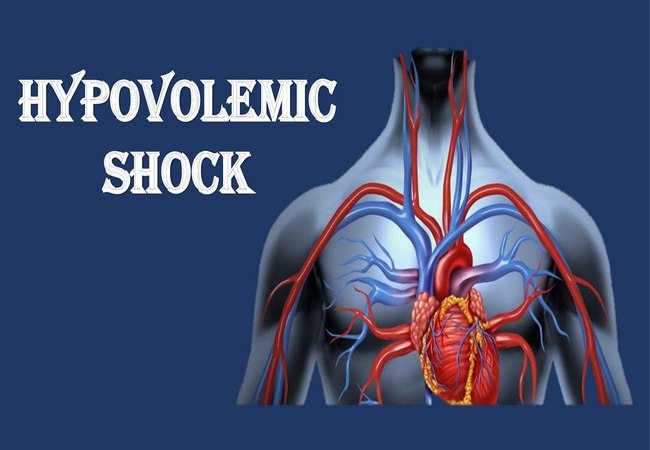Definition of Shock:
Shock is a medical emergency in which the organs and tissues of the body are not receiving an adequate flow of blood. Shock can result in serious damage or even death.
Definition of Hypovolemic Shock:
Hypovolemic shock is an emergency condition in which severe blood or fluid loss makes the heart unable to pump enough blood to the body, This type of shock can cause many organs to stop working.

Sign and Symptoms of Hypovolemic Shock:
Signs of Hypovolemic Shock:
1. Early sings:
- Paleness, excessive sweating (diaphoresis),
- Dilated pupils,
- Increased heart rate (tachycardia, may not occur early in patients who take beta-blockers),
- Weak, wide pulse,
- Signs of gastrointestinal bleeding: blood in the nose, mouth, throat or rectum (rectal examination).
2. Late signs:
- Early signs plus the following:
- Mottled, cyanotic skin,
- Increase of tachycardia for at least 30/min upon standing,
- or Decreased or absent urination (<20 mL/hour),
- Coma.
Symptoms of Hypovolemic Shock:
1. Early symptoms:
- Thirst due to hypovolemia (hypovolemic thirst) can appear after 15% blood loss,
- Nausea,
- Anxiety, irritability, agitation, sleepiness, confusion.
2. Late symptoms:
- Dizziness,
- Weakness,
- Confusion,
- Lethargy.
Causes of Hypovolemic Shock:
A number of conditions may cause hypovolemic shock, many of which are serious conditions This may include:
- Decreased blood clotting ability,
- Diarrhea or vomiting,
- Excessive sweating (which can result from heat exposure),
- Extremes of age (infants and the elderly may be unable to take fluids),
- Kidney diseases resulting in increased urination,
- Ectopic pregnancy (life-threatening pregnancy growing outside the uterus),
- Internal bleeding (often from the gastrointestinal tract, although it can develop elsewhere),
- Large burns,
- Ruptured aortic aneurysm (bulging and weakened aortic artery wall that can burst and cause, severe hemorrhage) or other vascular abnormalities,
- Sepsis (blood infection),
- Serious injury or trauma.
Nursing Management of Hypovolemic Shock:
- Check for patent airway and adequate circulation.
- Begin an I.V. infusion with normal saline solution or lactated Ringer’s solution delivered through a large bore.
- Help insert a central venous line and pulmonary artery catheter for hemodynamic monitoring.
- Insert an indwelling urinary catheter.
- Draw an arterial blood sample to measure ABG levels.
- Obtain and record the patient’s blood pressure, pulse and respiratory rates, and peripheral pulse rates.
- Monitor the patient’s CVP, right arterial pressure, pulmonary artery pressure, and cardiac output at least hourly as ordered.
- Measure the patient’s urine output hourly.
- Monitor the patient’s ABG and electrolyte levels frequently as ordered.
- Watch for signs of impending coagulopathy such as petechiae, bruising, bleeding or oozing from guns or venipuncture site.
- Explain all procedures and their purposes to ease the patient’s anxiety,
- Discuss the risk associated with blood transfusions to the patient and his family.

Maria Khatun Mona is a Founder and Editor of Nursing Exercise Blog. She is a Nursing and Midwifery Expert. Currently she is working as a Registered Nurse at Evercare Hospital, Dhaka, Bangladesh. She has great passion in writing different articles on Nursing and Midwifery. Mail her at “[email protected]”

